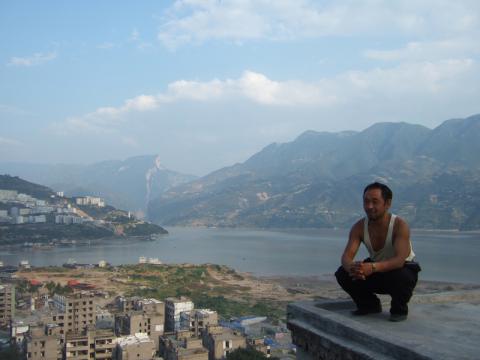RYAN WAAL ON JIA ZHANGKE'S 'STILL LIFE'

These notes on Jia Zhangke's Still Life were written by UW student Ryan Waal ('15). Jia Zhangke's newest film, A Touch of Sin, will have its only area theatrical screening at the Cinematheque on Friday, December 13 at 7 p.m.
When we think of modernization, we tend to think of big things: infrastructure, technologies, economies, societies. People tend to think about progress through these larger structures because they make change easily identifiable. But in the midst of these larger changes, it’s easy to forget about the people that change happens to, and the ways in which modernity descends upon their lives.
Still Life, director Jia Zhangke’s 2006 drama which won the Golden Lion at the Venice Film Festival, is about these smaller stories of change and progress, crafting characters that struggle to forge their own, personal progress against the backdrop of a Chinese city which is itself in a state of transition. Perhaps the biggest accomplishment of this immensely soulful, visually sumptuous film is that it shows both the tragedy and the beauty of change, simultaneously mourning the loss of past traditions while reminding of the need to move forward.
Set in Fengjie, a city irreparably altered by the creation of China’s Three Gorges Dam, the film unfolds over the course of four chapters—“Cigarettes,” “Liquor,” “Tea” and “Toffee.” Han Sanming (played by an actor of the same name), returns to Fengjie sixteen years after leaving, in search of a wife and daughter he lost contact with. When he gets there, the ways in which his home has changed are immediately apparent; after docking, a street magician forces Han to watch a magic trick and then gets mad when he doesn’t want to pay him for it. The corrupting influence of capitalism is readily apparent. When Han takes a taxi to his former address, Jia presents an enormous shot of his street submerged in the dam’s flood waters, which only continue to rise. While searching for his family, Han takes a job as a demolitions worker. Still Life presents a Chinese society replete with destruction of the past.
Running parallel to Han’s story is Shen Hong (Zhao Tao), a nurse who also travels to Fengjie to reconnect with family—in her case, an estranged husband who she has barely spoken to in years. Like Han, Shen is lost in the chaos of the new, modernized Fengjie, where the landscape is so crammed with people, businesses and demolished buildings that finding anything in particular is a struggle. Shen and Han never meet face to face in the film, although their journeys almost intersect at various moments. While both characters initially seem partially culpable for their problems, the movie reveals both of them to be victims of modernity more than anything else. There is a sense that these characters, with their shared feelings of regret and dislocation, and their comparable struggles for achieving closure, could find solace with one another if they had the chance.
Jia’s vision of present-day China is incredibly complex. The film’s four chapters each constitute a different commodity of exchange in Fengjie; old values of generosity and brotherhood have been replaced by quid pro quo and outright theft. Modern influence manifests itself in ways that are funny—when characters do impressions from martial arts movies and jam out to ring tones—and tragic—when people abandon their partners for career opportunities.
In keeping with its themes of modernity, Jia filmed Still Life in a most modern—and controversial—format: high-definition digital video. Film purists who deny the legitimacy of digital filmmaking should give this movie a chance; cinematographer Yu-Lik Wai’s camera renders Fengjie wonderfully, absorbing all the grime, dirt and fog as well as the golden sunlight, green hills and enormous bodies water which envelop it. The film’s photography also evinces the influence of Michelangelo Antonioni; the opening shots of the film contain slow, 180-degree pivots across characters that appear in films like La’aventura.
Critics have also noted Jia’s Antonioni-like use of images to convey emotional or thematic subtext. The film’s final shot, a flourish of visual poetry whose exact meaning still eludes me, will leave viewers appropriately confounded. And while, on the surface, the film is a restrained character-drama, it also contains several moments of baffling wonder and cinematic intrigue. There are scenes of magical realism, as when a UFO appears out of nowhere or a demolished building blasts off like a spaceship. One character’s tragic death is handled with such cinematic skill that you will never see it coming, even after it’s happened.
Many critics have viewed Still Life as a lamentation, a sorrowful docudrama of the ways that socio-economic change has disenfranchised China’s people. But I don’t see this so much as a sad film, but rather, a realistic one. Shen and Han’s stories end with renewed hope, and amidst the oppression of change, the citizens of Fengjie have all found ways to keep spirits high and full. These people have uncovered a necessary truth: the floods will come whether we want them or not. We can either find higher ground, or drown. We can’t just stand still.
-Ryan Waal
Still Life can be purchased through Amazon.com and rented through Netflix.
